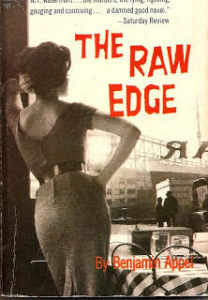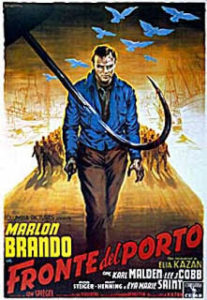On July 14, 1939, the longshore leader Pete Panto disappeared into a dark sedan with some “tough mugs” in Brooklyn. In the 80 years since his murder he has haunted the waterfront and its novels, plays, and films—most recently Arthur Miller’s long-lost drama The Hook, which had its American debut in Brooklyn this summer.
__________________________________
In the few existing pictures of Pietro ‘Pete’ Panto he wears a dark fedora, black mustache, and an easy smile that sometimes showed a gap in his teeth. His face suggests a more lighthearted person than the battling saint remembered after he had led a revolt of Brooklyn dock workers. “Pete became a saint like they carry on St. Anthony’s Day,” a veteran of many waterfront battles, Vincent ‘Jim’ Longhi, declared decades later. “Everybody knew who did the job on Pete.”

Panto had arrived on the waterfront some time in the middle thirties, then underwent a period of breaking in as a longshoreman. By 1937 the 26-year-old Panto had secured his union card and a regular job at the Moore McCormack line’s Brooklyn pier 15. At the foot of Brooklyn Heights, the Moore-Mack pier jutted into the East River just upstream from the cabled span of the Roeblings’ Brooklyn Bridge and looked across to the bottom of Manhattan and the Staten Island ferry sheds.
The five-mile stretch of Brooklyn shore that ran from Brooklyn Bridge to Twentieth Street was overwhelmingly staffed by lower-paid Italians who worked the less desirable cargoes and piers. Some four thousand dockers labored in “Camarda locals” like Panto’s. Mob-held piers resembled company towns. On the Camardas’ waterfront, wrote Brooklyn Assistant District Attorney Burton Turkus, everyone “from candy store proprietor to ship line operator” had “to pay tribute to the Mob.”
Disgusted by the rackets and graft that were a regular part of getting hired, Panto led a growing rebellion of Italian longshoremen against the Brooklyn union leadership of the Camardas and International Longshoremen’s Association President Joe Ryan (whose Manhattan offices were high in the current Google building in Chelsea). In the spring of 1939, when ILA locals like his hadn’t gathered in decades, Panto led a series of increasingly large and rowdy mass meetings of local 929.
Crowding before the piers at night, hundreds of men heard Panto hold forth in increasingly bold speeches demanding greater union democracy—regular shop meetings and an end to the shape up and kickback system. In mid-June, 350 union men heard him speak again about waterfront corruption, and he addressed a larger group of longshoremen on July 3rd. Panto’s speeches (often in Italian) against the gangsters’ set-up eventually caused him to be called to the President Street office of Emil Camarda, who advised him that “the boys” (i.e., Mob people like Albert Anastasia) did not like what he was up to. Panto defied the warning and addressed a public meeting that included obvious spies for Anastasia. Then on the night of July 8th, he surrounded himself with some 1250 longshoremen at a boisterous open air meeting near the piers, the street echoing with the rough eloquence of his Italian speechmaking and the derisive laughter of the men.
Six days later, on the afternoon of Friday, July 14th, Panto left the Moore-Mack pier at five o’clock and headed home to his rooming house on North Eliot Street, near the high stone walls of the Navy Yard. He was shaving for a later date with his fiancée, Alice Maffia, when someone came to the room with word that Panto had a mysterious phone call at the corner store. Panto made his way downstairs, then returned looking uncharacteristically shaken. He told his fiancee’s younger brother he would be meeting “two tough mugs” or some “men I don’t like” for an hour or so that night, and that “If I don’t get back by 10:00 o’clock tomorrow morning, tell the police.”
At seven that evening a car belonging to Gus Scannivino, one of several Brooklyn ILA vice presidents, appeared before Panto’s building. In the car with Scannivino were an Anastasia man named Tony Romeo, and Emil Camarda himself. Since Panto was not expecting a long meeting he left behind his wallet and empty suitcase and his work clothes were still laid out on his bed. Dressed in his best suit and dark fedora for his later date with Alice, he climbed inside the car with the other men, who had probably all driven over together from Camarda’s office. The sedan rolled away down his Brooklyn street into the summer evening and Peter Panto was gone.
* * *
Panto’s vanishing ignited a graffiti campaign among Italian longies in Brooklyn, who wrote dov‘e Panto? (“Where is Panto?”) on subway and office walls, the sides of boxcars and waterfront warehouses. Leaflets titled, “Where is Pete Panto?” were stealthily dropped by longshoremen before Red Hook shipping offices and social clubs and in the area around the Navy Yard. That summer, the World’s Fair drew thousands to New York, but it was a fearful season along the Brooklyn waterfront, where each sodden corpse pulled from the East River was checked against photos of the hero of the docks. The graffiti campaign gradually drew the interest of strangers to the cause: “Police fear,” wrote the gossip columnist Walter Winchell, “Pete is wearing a cement suit at the bottom of the East River.”

The Brooklyn dock rackets were backed by the violent threat of Vincent Mangano, a waterfront racketeer whose crime group was a progenitor of the long-lived Gambino organization. Mangano had brought in the murder expert Albert Anastasia to protect his waterfront businesses. By the mid-1930s Anastasia managed the execution arm of the syndicate (or “combination,” as its members called it). This systematic squad of largely Italian and Jewish murderers served the newly organized national syndicate and invented the anonymous “contract” killing that’s been a staple of Mob movies ever since.
It wasn’t until Abe “Kid Twist” Reles left the Tombs prison for the Brooklyn Municipal Building early one morning in 1940 that the D.A.’s office first learned the Combination was responsible for as many as 1000 murders nationwide throughout the thirties. “In Brooklyn,” Reles told D.A. William O’Dwyer, “We are all together with the Mob on the docks.” When the full grisly picture of the national syndicate’s killing “troop” finally emerged, the press would memorably name it “Murder, Inc.” with the beefy, dark-eyed Anastasia the outfit’s “Lord High Executioner.”
When the rackets were threatened by Panto’s rebellion, it was a matter of time before Anastasia would be asked to remove the threat.
Wherever Panto believed he was going for a meeting when he stepped into that car, he was whisked to a Jersey house regularly used by Anastasia, where Mendy Weiss strangled him; when questioned later about scratches on his hands, Weiss expressed regret over the killing to a colleague in the business. To Reles he confessed, “I hated to take that kid.”
Almost 18 months later, in January 1941 Panto’s trussed up body was unearthed inside a canvas sack buried on a chicken farm in Lyndhurst, New Jersey. His friend and successor in the struggle, Pete Mazzie, identified him from the familiar gap in his teeth, and his body was brought back to Brooklyn under guard.
Emboldened by the death verdict, Bals told him as he passed, “Peter Panto is waiting for you.”The top tier of Murder Inc. was decimated by Abe Reles’s testimony. But before he could testify about Albert Anastasia’s role in the Panto killing he mysteriously fell, jumped, or was pushed from a sixth floor window of Coney Island’s Half Moon hotel where he was allegedly under police protection. (D.A. O’Dwyer alleged that the case against Anastasia went “out the window” with Reles.) But his testimony had sent other top members of the Combination to the electric chair, including Buchalter, the highest ranking Mob figure ever sentenced to death, and Mendy Weiss, who had killed Panto in the Jersey farmhouse. As Weiss turned to leave the courtroom, Capt. Frank Bals, under whose watch Reles’s death had spectacularly occurred, caught the killer’s eye. Emboldened by the death verdict, Bals told him as he passed, “Peter Panto is waiting for you.”
Panto’s brief career echoed in everything that came afterward, both as an inspiration and as a ghoulish picture of what happened to brave guys who stood against the mob. The Panto case later seized the imaginations of many writers who set their books, plays, and movies on the mobby docks.
* * *
Since January 1941, when he was dug up on information from Abe Reles, Panto has died many times in books and movies, most recently this past June, when an adaptation of Arthur Miller’s Panto-themed screenplay, The Hook, finally had its American debut on the Waterfront Barge Museum in Red Hook. The Brave New World Repertory Theatre’s production, (adapted for the stage by the Irish screenwriter Ron Hutchinson), opened each night with the audience going through a longshoremen’s shape-up, chosen by a pier boss for the considerable privilege of taking their seats for the human drama.
Vincent Longhi had been Arthur Miller’s guide to the 1940s Brooklyn docks world when he wrote The Hook, and inspired the lawyer character ‘Alfieri’ in Miller’s A View from the Bridge. After The Hook was first turned down by Hollywood as politically unpalatable, Longhi wrote his own Panto-themed play, Two Fingers of Pride. It premiered at the Orunquit Playhouse in Maine in 1955. Although the drama did not jump as hoped to Broadway, it gave an early break to a young Indianan who’d perfected his Brooklyn accent at the Actors’ Studio, Steve McQueen.

Another Panto drama did make it to Broadway only months after his body had been unearthed. Panto rose again in a 1941 play written by two former crime reporters, “Brooklyn USA,” which took on the whole waterfront rackets problem, insofar as a stage play can ever pose much of a nuisance to criminals. For 57 performances it portrayed the excruciating ice-picking death of a Panto-like labor crusader named Nick Santo and featured characters with recognizably scummy antecedents in Murder Inc.
The single survivor of all the play’s prosecutions and deaths was a mob boss called simply ‘Albert.’ “The murder of Santo in a wretched barber-shop late at night is about the most harrowing episode in the theatre for years,” wrote the Times’s Brooks Atkinson. “Nothing could distinguish racketeering from the popular game of murder and mystery better than this one sketch of demoniac violence.” Anastasia may not have been arrested in the death of Panto, but audiences were assured of ‘Albert’s’ guilt night after night.

In Benjamin Appel’s pulp novel The Raw Edge (1958), Panto appears as Pete Pironi, a Brooklyn docker who pushes back against the racketeers, in fatal defiance of the waterfront code. Some real names appear in the novel, and some are close: instead of the racketeer Squint Sheridan, there’s Squint Donahue, a gunman who’s moved up as a waterfront mobster on the West Side, and still bears the tattoo of dove’s wings on his gunhand. (When he shoots, they seem to flutter.) In dark, leafy Brooklyn there’s the coming clash between ‘Joe the Boss’ Dinetti and Pete Pironi, a troublemaking “wop money couldn’t buy.” The controlling Camarda family are known as the Rosatis, and a version of the fateful meeting between the real Pete Panto and Emil Camarda is dramatized. For anyone who has walked around gentrified Brooklyn today, Pironi’s working-class neighborhood of the late thirties is an old-world departure, with its “soft, whitish, chattering shapes of women” on stoops and “men arguing about Il Duce” and smoking “black twisted cigars.”

Appel’s book was one of a number of realistic works inspired by the New York Crime Commission hearings in the early fifties, from which Budd Schulberg also drew anecdotes and some famous lines for On the Waterfront (“I’ll take it out of their skulls!”). That movie did not begin as the Panto story but rather as an unproduced docu-drama chronicling the Pulitzer-winning waterfront investigations of the New York Sun’s Mike Johnson.
But after Schulberg mortgaged his farm and bought the film rights, the masterpiece he made with Elia Kazan did end up reckoning with Panto’s choice, as all waterfront crime stories must: Panto’s ghost haunts the story of Terry Malloy discovering his conscience in order to fight the racketeers who have both ruined and fed him. A man who started out as heroic as the real-life Panto would be hard to believe in a Hollywood film, where flaws must be revealed in order for us to identify. In life, no one could tell Peter Panto, “Tonight’s not your night. We’re going for the price on Wilson.” Panto took a dive for no one, and he died for it.
***
Drop hooks all you longshoremen
This Panto burial day
This working man from off the docks
Our martyr in the fray.
—From a poem read by men in the street outside Panto’s 1941 funeral
__________________________________
Nathan Ward is the author of the Edgar-nominated The Lost Detective: Becoming Dashiell Hammett, as well as the earlier Dark Harbor: The War for the New York Waterfront, from which some of this was adapted.

















